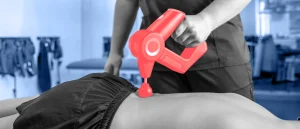
Workouts Feeling Too Hard? Improve This Metric to Make Them Easier
- By Sydney Bueckert, NASM C.P.T., C.E.S., F.N.S., G.P.T.S.
- Medically reviewed by M.D. jack jeng
- November 10, 2022
Fast Facts
- VO2 max is an important metric that can help you fine tune your fitness performance.
- The higher your VO2 max, the harder you can work and the longer you can last.
- You can improve your VO2 max with endurance and interval training.
Unless you’re a pro athlete, VO2 max might sound like something straight out of your high school chem class. Before you *immediately* tune me out, hear this: VO2 max isn’t periodic table jargon—it’s widely known as the best indicator of cardiovascular endurance and aerobic performance.
This benchmark metric is becoming more common as everyday gym-goers are working out like athletes and turning to advanced technology to exercise smarter.
If you’re looking to shave a few seconds off your 5K PR, run a sub-4-hour marathon, or cut down your MURPH time, a high VO2 max could help you get there. Here’s everything you need to know.
What Is VO2 Max?
As the intensity of your workout creeps up, so does the amount of oxygen your body needs. That’s because your body uses oxygen as the primary fuel source to generate energy (also known as ATP), which powers you through sustained periods of effort.
You know a tough workout comes with some huffing and puffing. What you may not know is that there’s a limit to how much oxygen your body is capable of using per minute. That maximum oxygen intake is called your VO2 max.
VO2 stands for volume (V) of oxygen (O2) and VO2 max is the highest amount of oxygen your body can use in a set amount of time. It’s expressed in millimeters of oxygen over kilograms of body mass per minute, which looks like this: ml/kg/min. The higher the number, the more cardiovascularly fit you are—and the easier a hard workout will feel.
Why Does It Matter?
Since the primary source of fuel for aerobic exercise is oxygen, your VO2 max greatly affects your performance. The higher your VO2 max, the more oxygen is available to your muscles—which means the harder they can work and the longer they can last (which is the goal of every performance sport).
Elite athletes typically have high VO2 maxes; but, even if you’re not an athlete, improving your VO2 max can improve your overall health. Low levels of cardiovascular fitness correlate with an increased risk of heart disease (1).
Increasing cardiovascular fitness is associated with:
What Is a Good VO2 Max?
Like heart rate or heart rate variability, there’s no “perfect” VO2 max. Your number will differ from others based on age, gender, fitness level, and outside factors like altitude. Untrained men typically have a VO2 max of around 35 to 40 ml/kg/min. For well-trained men or elite athletes, that number could be well above 50 to 60 ml/kg/min (9).
Reference the chart of men’s VO2 Max results sorted by age to see how you stack up. These numbers come from the Fitness Registry and Importance of Exercise National Database (FRIEND), a national database for VO2 scores.
|
Age Group |
5th |
10th |
25th |
50th |
75th |
90th |
95th |
|
20-29 |
29.0 |
32.1 |
40.1 |
48.0 |
55.2 |
61.8 |
66.3 |
|
30-39 |
27.2 |
30.2 |
35.9 |
42.4 |
49.2 |
56.5 |
59.8 |
|
40-49 |
24.2 |
26.8 |
31.9 |
37.8 |
45.0 |
52.1 |
55.6 |
|
50-59 |
20.9 |
22.8 |
27.1 |
32.6 |
39.7 |
45.6 |
50.7 |
|
60-69 |
17.4 |
19.8 |
23.7 |
28.2 |
34.5 |
40.3 |
43.0 |
|
70-79 |
16.3 |
17.1 |
20.4 |
24.4 |
30.4 |
36.6 |
39.7 |
How to Increase VO2 Max
Many factors that play into your VO2 max, like age, gender, and genetics, are out of your control. Although there are others you can control, such as your training level, the type of training, the altitude where you’re training, and overall mass. Here’s how to tweak your training to maximize aerobic gains.
Train for Endurance
To improve your VO2 max, hammer steady-state cardio. Training for endurance, particularly in zone 2 (which is a pace that you can sustain a conversation for over an hour), strengthens your heart, increases aerobic fitness, and improves VO2 max (10).
Try an endurance-based workout like this at least once a week for best results:
- Sustained, zone 2 cardio for 45 minutes to 3 hours; rate of perceived exertion (RPE) 5 to 6 out of 10 (with 10 being your max effort)
Try Interval Training
Interval training consists of alternating short periods of high-intensity exercise with rest. One study found that a routine including interval training or a combo of interval training and steady-state cardio resulted in higher VO2 max results than continuous steady-state cardio alone (11).
These results aren’t surprising, since we know working near your max heart rate helps to strengthen the heart, and increases the volume of blood it can pump with each beat (12).
Try a workout using these interval frameworks for the best adaptations:
- Intervals 1 to 5 minutes in duration at an effort level just above threshold effort; RPE 8 out of 10
- Intervals 5 to 20 minutes in duration at an effort level just below threshold; RPE 6 to 7 out of 10
Keep Challenging Yourself
To increase your performance capacity, a challenge is a must. When you first start training, any endurance activity will have a positive effect, because everything is hard. As you build fitness, the gains will slow down and you’ll have to train at a higher level to keep improving.
You can train harder by increasing the duration of your workout, increasing your speed, or adding resistance (like a hill, sled, or weighted vest).
How Long Does It Take?
If you’re currently inactive, you’ll likely notice improvements in your VO2 max within four to ten weeks of regular training. The fitter you are, the longer it will take to see an increase. For well-trained athletes, it can take several months, years, or training cycles to see improvements. Be patient and consistent and you will see a bump over time.
How to Measure VO2 Max?
There are multiple ways to measure VO2 max. The gold standard is a stress test in a medical lab or sports medicine facility. During the test, you’ll wear a special face mask that measures the volume of air you breathe in and out as you exercise (typically on a stationary bike or treadmill). You then work progressively harder at intervals until you reach your limit.
Unless you’re an elite athlete, going to a lab is expensive and impractical. Fitness trackers and online calculators are other ways to estimate your VO2 max from home. Although these alternatives are less accurate than a test in the lab, the convenience trade-off is massive.
A few of the best fitness trackers that can estimate VO2 max include the Apple Watch Ultra, Garmin Fenix 7, Garmin Enduro, and Fitbit Charge 5.
If you don’t have a tracker, you can use an online calculator. The most accurate VO2 max online calculator was created by the Norwegian Institute of Science and Technology. It’s based on the results of a study of a large population of people and gives you an estimated VO2 max based on your answers to a series of detailed questions.
Keep in mind, for average Joes accuracy is less important than the ability to consistently measure change. So pick a method, and stick with it to see how you improve over time.
SHOP VO2 FITNESS TRACKERS
Example VO2 Max Workouts
Start improving your VO2 max with these sample workouts designed for beginners. These workouts can be completed using your cardio of choice—running, cycling, rowing, swimming, hiking, and the elliptical are all fair game. Remember a blend of endurance and interval training yields the best VO2 max improvements, so try including a variety of the following workouts in your routine.
Workout 1: Endurance Workout
Sustained, zone 2 cardio for 45 minutes to 3 hours; RPE of 5 to 6 out of 10.
Determine the total time for your session based on your fitness level. If this is your first time, start with what you can tolerate (it might be 10 minutes, it might be 20). Build your sessions gradually from there, adding on about 5% volume each week. Not everyone will need to build up to three hours to increase VO2 max; however, if you participate in endurance sports like marathons or triathlons you may particularly benefit from longer training stints.
Workout 2: Interval Workout
4x 3:00 intervals at an RPE of 8 out of 10 with 3:00 recovery.
The pacing for this interval workout isn’t quite an all-out sprint, but it’s not slow and easy like zone 2 either—it lands somewhere in the middle. To find the right pace, hop into the workout. When you hit a pace where you’re both questioning but somewhat confident you can make it through the interval, you’ve hit the target (hint: it should feel really f-ing hard).
Workout 3: Fartlek Workout
Complete a 2:00 interval at an RPE of 5 to 6 out of 10, followed by a 1:00 interval at an RPE of 8 to 9 out of 10. Repeat 8 times.
Fartlek workouts are a form of interval training that involves continuous exercise at various speeds (as opposed to traditional interval training where you get a complete rest between high efforts). Because you never get a total rest, fartlek workouts are one of the most challenging workouts you can do, and should only be completed once a week to give your body adequate rest.
The Bottom Line
Your VO2 max can provide useful insight into your cardiovascular fitness. Boost it by doing a blend of endurance and interval training, and continuing to push yourself harder over time. Improve your VO2 max, and you can expect a bump in performance; but, don’t forget it’s only one factor. Your movement economy, fueling strategy, pacing strategy, execution, and mental skills come into play on race day, too.
References
1. Ozemek, C. et al (2018). An Update on the Role of Cardiorespiratory Fitness, Structured Exercise and Lifestyle Physical Activity in Preventing Cardiovascular Disease and Health Risk. https://www.sciencedirect.com/science/article/abs/pii/S0033062018302202
2. Ortega, F. et al (2018). Fitness and Fatness as health Markers through the Lifespan: An Overview of Current Knowledge. https://www.ncbi.nlm.nih.gov/pmc/articles/PMC7328664/
3. Evaristo, S. et al (2019). Muscular fitness and cardiorespiratory fitness are associated with health-related quality of life: Result from labmed physical activity study. https://www.sciencedirect.com/science/article/pii/S1728869X18300832
4. Prestgaard, E. et al (2018). Change in Cardiorespiratory Fitness and Risk of Stroke and Death. https://www.ahajournals.org/doi/full/10.1161/STROKEAHA.118.021798
5. Qiu, S. et al (2019). Association Between Cardiorespiratory Fitness and Risk of Type 2 Diabetes: A Meta-Analysis. https://onlinelibrary.wiley.com/doi/abs/10.1002/oby.22368
6. Imboden, M. et al (2019). The Association Between the Change in Directly Measured Cardiorespiratory Fitness across Time and Mortality Risk. https://www.sciencedirect.com/science/article/abs/pii/S0033062018302469
7. Troutman-Jordan, M. et al (2020). Physical Activity, Cardiovascular Health and Mood State in Older Adults. https://www.sciencedirect.com/science/article/abs/pii/S0197457220301725
8. Osailan, A. et al (2021). The Association between Cardiorespiratory Fitness and Reported Physical Activity with Sleep Quality in Apparently Healthy Adults: A Cross-Sectional Study. https://www.mdpi.com/1660-4601/18/8/4263
9. Kaminsky, L et al (2015). Reference Standards for Cardiorespiratory Fitness Measured With Cardiopulmonary Exercise Testing: Data From the Fitness Registry and the Importance of Exercise National Database. https://www.mayoclinicproceedings.org/article/S0025-6196(15)00642-4/pdf
10. Aliberti, S. et al (2021). Three Workouts Compared: Interval Training, Intermittent Training and Steady State Training for the Improvement of VO2 Max and BMI. https://www.researchgate.net/profile/Hakim-Hamzaoui/publication/358291705_Efficiency_Eight_Weeks_Program_of_CrossFit_Exercises_on_the_Level_of_Physical_Fitness_of_Algerian_High_School_Students/links/6253f3f2b0cee02d69630ba8/Efficiency-Eight-Weeks-Program-of-CrossFit-Exercises-on-the-Level-of-Physical-Fitness-of-Algerian-High-School-Students.pdf#page=77
11. Bacon, A. et al (2013). VO2 Max Trainability and High-Intensity Interval Training in Humans: A Meta-Analysis. https://www.ncbi.nlm.nih.gov/pmc/articles/PMC3774727/
12. Bruss, Z. et al (2022). Physiology, Stroke Volume. https://www.ncbi.nlm.nih.gov/books/NBK547686/












